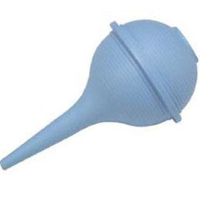Ear Wax Bulb Syringe Pathway
Self-Treatment of Ear Wax with the Bulb Syringe
(You can find more advice about ear wax impaction on the website www.patient.co.ukunder patient information)
What is a bulb syringe and where do I get it?
The ear bulb syringe is shown below. It is a small bulb shaped rubber object that will
fill with water and allow the user to squirt the water gently into the ear to remove earwax. You can buy it from most pharmacies or on-line. It costs about £3 to £4.

When should a bulb syringe be used?
An ear bulb syringe should be used when one or both ears are blocked with wax. This is called wax impaction. The ears are usually self-cleaning as the skin cells of the ear drum and ear canal are constantly migrating outwards and most people do not need to interfere with their ears at all. Some people make more wax or their ears do not clean the wax as effectively as others. In these cases wax can build up inside the ear sometimes causing a blockage sensation and reduced hearing.
You can treat earwax impaction with eardrops in the first instance. Olive oil eardrops or sodium bicarbonate can be put into the ear daily. This should be done for 2-3 weeks and can treat the earwax blockage without the need for a bulb syringe. Both these drops can be bought over the counter in the pharmacy. If this is unsuccessful then the bulb syringe can be used.
Should I use cotton buds in my ears?
Never use cotton buds in your ears!! – This pushes wax further into the ear making it worse. It can also cause ear infections and damage the eardrum. Cotton buds should NEVER be put inside the ear.
What are the benefits of the bulb syringe?
The main benefit of the bulb syringe is that you can use it yourself without needing to make an appointment with your practice nurse or GP. It is cheap to buy and can be re-used.
How effective is the bulb syringe?
A study on the use of the bulb syringe showed that half of patients who use it are successfully treated. Ear syringing by a practice nurse has been proven to be slightly more effective but it may be sensible to try the ear bulb syringe first.
Is it safe and what are the risks of using a bulb syringe?
The use of the bulb syringe is commonly used in the USA and Europe. Two studies have shown the bulb syringe to be safe treatment.
The risks of using the bulb syringe include ear infection, failure to remove the wax and eardrum perforation. These risks are low.
When should a bulb syringe not be used?
- Do not use a bulb syringe in the following circumstances:
- Pain in the ear
- A history of ear drum perforation in the affected ear
- A recent history of an ear infection in the affected ear.
- Symptoms of Infection in the ear – usually pain or a smelly discharge
- If you have an offensive discharge from the ear – this may mean you have an infection in the ear.
- If you only have one hearing ear which is the affected ear.
- Previous ear surgery on the affected ear
In the above circumstances make an appointment to see your practice nurse or GP to have your ears examined and appropriately treated.
What if my ears are still blocked with wax after using the bulb syringe?
The procedure can be repeated but if it fails make an appointment with your practice nurse to examine your ears and try syringing. If this fails you may be referred for microsuction of the ears.
Do I have to treat ear wax impaction (blocked ears from wax)?
No. If your ears being blocked with wax do not particularly trouble you do not have to treat it. You can use olive oil or sodium bicarbonate drops daily and this will help the ears to clear themselves. You can get these drops over the counter in any pharmacy.
How do I use the bulb syringe?
The bulb syringe will most likely come with instructions but below is some advice on how to use the bulb syringe:
1. Firstly, use olive oil or sodium bicarbonate eardrops in the ear daily for 2-3 weeks. Apply a generous amount twice daily into the ear leaving the ear uppermost for 5 to 10 minutes after applying. If this does not clear the wax then the bulb syringe can be used.
2. Put some clean warm (not hot) water in a bowel. Squirt the bulb syringe in the water a few times to fill it up with the warm water.
3. Hold your head to one side so the affected ear is facing upwards. You can do this in the shower or bath or lie on the bed with a towel underneath your head.
4. If you experience any pain during or before this procedure stop immediately and see your practice nurse or GP for a review.
5. Gently pull your ear in an upward and outwards direction so that the water gets better access to the ear canal. Hold the nozzle inside the ear canal (not too deeply) and GENTLY squirt
the water from the bulb syringe into the ear. You can gently squirt more bulb syringes into the ear if required. Leave the water in your ear for 1-3 minutes to soften the wax.
6. Now tilt your head over the sink so the water can fall out. Wiggle the outer part of the ear to help the water and wax come out. You can repeat the procedure if required.
7. Repeat for the other ear if both ears are affected.
8. If you get any pain or if the procedure is unsuccessful, see your practice nurse or doctor.